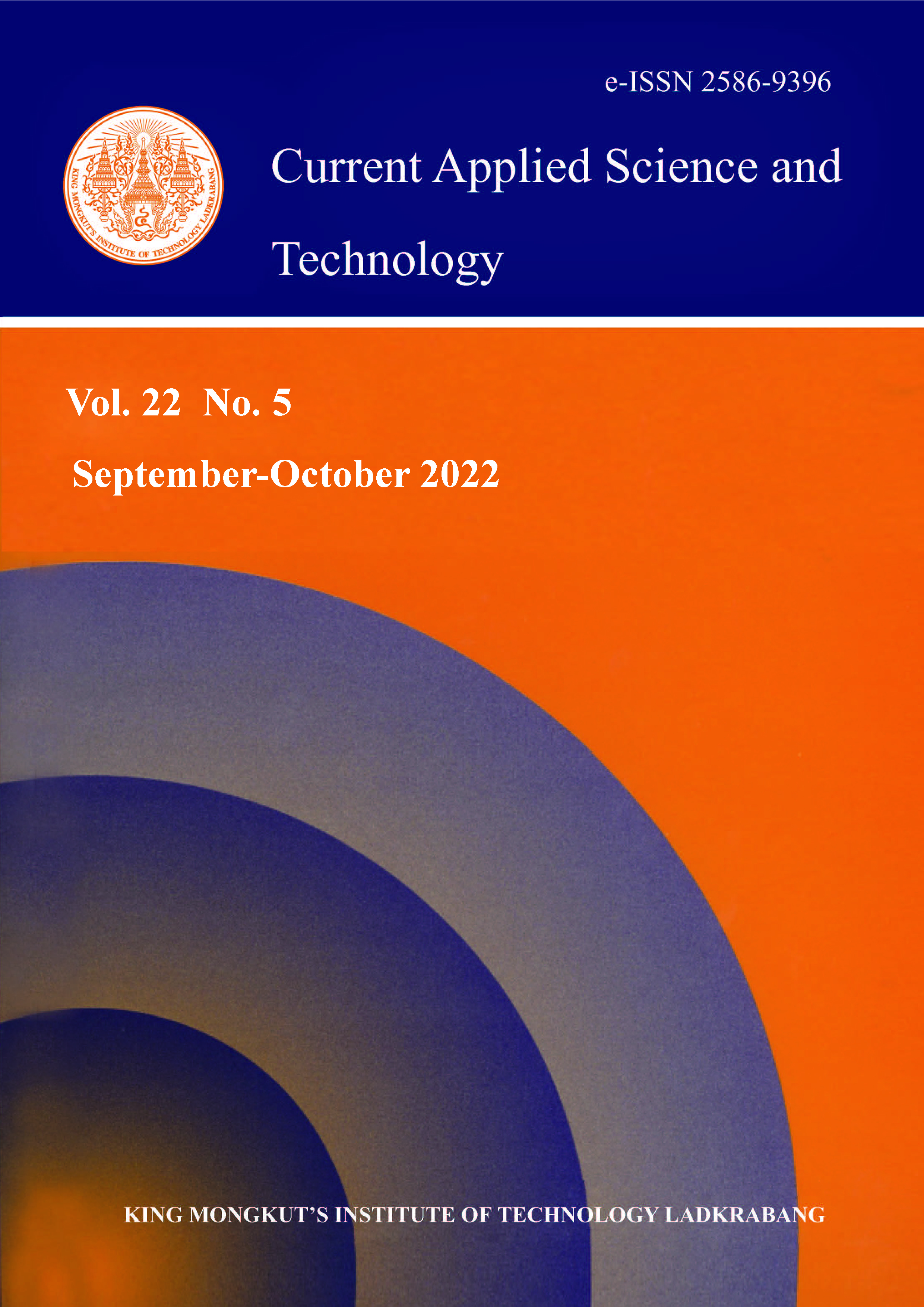Characterization and Properties of Biodegradable Thermoplastic Arrowroot Starch Crosslinked by Glutaraldehyde Processed by Compression Molding Technique
Main Article Content
Abstract
Although starch is available and biodegradable, hydrophilicity and mechanical properties are still main disadvantages for many applications. In this study, arrowroot starch, a perennial herb found in tropical climates and extracted from the tubers of the arrowroot plant was used. The arrowroot starch was chemically modified by crosslinking with different amounts of glutaraldehyde in order to overcome the starch disadvantages. The crosslinked starch was then prepared as thermoplastic starch by plasticizing with glycerol, compounding in an internal mixer and finally shaping in a compression molding machine. An increase of gel fraction and decrease of swelling as well as the moisture uptake of different thermoplastic crosslinked arrowroot starch samples were observed, all of which indicated a crosslinking reaction of glutaraldehyde with the starch molecules. The thermal degradation temperature of thermoplastic crosslinked arrowroot starch, determined from thermogravimetric analysis technique, increased when compared with thermoplastic arrowroot starch. The extensibility of the thermoplastic crosslinked arrowroot starch also improved via glutaraldehyde crosslinking. Higher content of glutaraldehyde also caused lower swelling and moisture uptake including higher gel fraction and extensibility. Moreover, crystallinity, morphology and biodegradability were also examined.
Keywords: arrowroot starch; biopolymer; crosslinking; thermoplastic starch
*Corresponding author: Tel.: (+66) 2329 8400 Fax: (+66) 2329 8428
E-mail: jutarat.si@kmitl.ac.th
Article Details

This work is licensed under a Creative Commons Attribution-NonCommercial-NoDerivatives 4.0 International License.
Copyright Transfer Statement
The copyright of this article is transferred to Current Applied Science and Technology journal with effect if and when the article is accepted for publication. The copyright transfer covers the exclusive right to reproduce and distribute the article, including reprints, translations, photographic reproductions, electronic form (offline, online) or any other reproductions of similar nature.
The author warrants that this contribution is original and that he/she has full power to make this grant. The author signs for and accepts responsibility for releasing this material on behalf of any and all co-authors.
Here is the link for download: Copyright transfer form.pdf
References
BeMiller, B. and Whistler, R.L., 2009. Starch: Chemistry and Technology. New York: Academic Press.
Chusut, T., Charoenchai, L., Sueree, L. and Amnuaikit, T., 2018. Physical properties of arrowroot starch with traditional extraction. Thai Journal of Pharmaceutical Sciences, 42(suppl.), 215-218.
Shuhada, N. and Makhtar, M., 2013. Thermal behavior of Tacca leontopetaloides starch-based biopolymer. International Journal of Polymer Science, 2013, 373854, https://doi.org/10.1155/2013/373854.
Curvelo, A.A.S., Carvalho, A.J.F. and Agnelli, J.A.M., 2001. Thermoplastic starch-cellulosic fibers composites: Preliminary results. Carbohydrate Polymers, 45, 183-188.
Weerapoprasit, C. and Prachayawarakorn, J., 2016. Properties of biodegradable thermoplastic cassava starch/sodium alginate composites prepared from injection molding. Polymer Composites, 37, 3365-3372.
Averous, L., Fauconnier, N., Moro, L. and Fringant, C., 2000. Blends of thermoplastic starch and polyesteramide processing and properties, Journal of Applied Polymer Science, 76, 1117-1128.
Prachayawarakorn, J. and Hwansanoet, W., 2012. Effect of silk protein fibers on properties of thermoplastic rice starch. Fibers and Polymers, 13, 606-612.
Mathew, A.P. and Durfresne, A., 2002. Plasticized waxy maize Starch: Effect of polyols and relative humidity on material properties, Biomacromolecules, 3, 1101-1108.
Kritthika, P.L. and Ratanamala, K.V., 2019. Modification of starch: A review of various techniques. International Journal of Research and Analytical Reviews, 6(1), 32X-45X.
Yeh, J.T., Hou, Y.J., Cheng, L., Wang, Y.Z., Yang, L. and Wang, C.K., 2015. Water proof and strength retention properties of thermoplastic starch based biocomposites modified with glutaraldehyde. Carbohydrate Polymers, 127, 135-144.
Parra, D.F., Tadini, C.C., Ponce, P. and Lugao, A.B., 2004. Mechanical properties and water vapor transmission in some blends of cassava starch edible films. Carbohydrate Polymers, 58, 475-481.
Liu, Z., Jiang, M., Bai, X., Dong, X., Tong, J. and Zhou, J., 2012. Effect of post crosslinking modification with glutaraldehyde on the properties of thermoplastic starch/poly(vinyl alcohol) blend films. Journal of Applied Polymer Science, 124, 3774-3781.
Yoon, S.D., Chough, S.H. and Park, H.R., 2006. Properties of starch-based blend films using citric acids as additive. Journal of Applied Polymer Science, 100, 2554-2560.
Yoon, S.D., Chough, S.H. and Park, H.R., 2006. Preparation of resistant starch/poly(vinyl alcohol) blend films with added plasticizer and crosslinking agents. Journal of Applied Polymer Science, 106, 2485-2493, https://doi.org/10.1002/app.26755.
Chen, C.T., Chen, K., Chiang, H.H., Chen, Y.K. and Cheng, K.C., 2016. Improvement on physical properties of pullulan films by novel cross-linking strategy. Journal of Food Science, 82, 108-117.
Li, H., Gao, X., Wang, Y., Zhang, X. and Tong, Z., 2012. Comparison of chitosan/starch composites film properties before and after crosslinking. International Journal of Biological Macromolecules, 52, 275-279.
Reddy, N. and Yang, Y., 2010. Citric acid cross-linking of starch films. Food Chemistry, 118, 702-711.
Wade, L.G., 2008. Organic Chemistry. London: Pearson Education.
Prachayawarakorn, J. and Tamseekhram, J., 2019. Chemical modification of biodegradable cassava starch films by natural mono-, di-and tri-carboxylic acids. Songklanakarin Journal of Science and Technology, 41, 355-362.
El-Tahlawy, K., Venditti, R.A. and Pawlak, J.J., 2007. Aspects of the preparation of starch microcellular foam particles crosslinked with glutaraldehyde using a solvent exchange technique. Carbohydrate Polymers, 67, 319-331.
Oyeyinka, S.A., Singh, S. and Amonsou, E.O., 2021. A review on structural, digestibility and physicochemical properties of legume starch-lipid complexes. Food Chemistry, 349, 129165, https://doi.org/10.1016/j.foodchem.2021.129165.
Mei, J.Q. Zhou, D.N., Jin, Z.Y., Xu, X.M. and Chen, H.Q., 2015. Effects of citric acid esterification on digestibility, structural and physicochemical properties of cassava starch. Food Chemistry, 187, 378-384.
Kaewtatip, K. and Thongmee, J., 2013. The effects of cross-linked starch on the properties of thermoplastic starch. Materials and Design, 45, 586-589.
Scopel, B.C., Pretto, G.L., Correa, J.I.P., Baldasso, C., Dettmer, A. and Santana, R.M.C., 2020. Starch-leather waste gelatin films cross-linked with glutaraldehyde. Journal of Polymers and the Environment, 28, 1974-1984.
Shi, R., Bi, J., Zhang, Z., Zhu, A., Chen, A., Zhou, X., Zhang, L. and Tian, W., 2008. The effect of citric acid on the structural properties and cytotoxicity of the polyvinyl alcohol/starch films when molding at high temperature. Carbohydrate Polymers, 74, 763-770.
Tena-Salcido, C.S., Rodriguez-Gonzalez, F.J., Mendez-Hernandez, M.L. and Contreras-Esquivel, J.C., 2008. Effect of morphology on the biodegradation of thermoplastic starch in LDPE/TPS blends. Polymer Bulletin, 60, 677-688.






